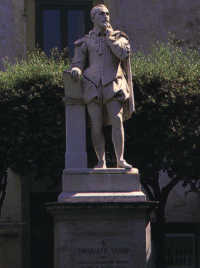|
Sorrento
Beaches
Marquety
Personages
Typical
Dishes Typical
Products Place
to Visit
ST.
ANTONINO
|
Still
very little is known of Saint Antonino's place and date of birth and
of the kind of life he led until he arrived in Stabia and was warmly
welcomed by Catello, bishop of that city, who then, retired to a life
of a hermit on Mount Faito and entrusted him with the task of the
spiritual direction of his diocese. But not much later, Saint Antonino
left his post and retreated to this mountain as well, and there, after
a vision of the archangel Gabriel they built together an oratory in
his honour.
In
the meantime, the fame of his holiness spread through the small nearby
towns and the Sorrentines begged him to settle with them. He accepted
their invitation, left the solitude life of Faito and Bishop Catello,
and entered into the Benedictine monastery of Saint Agrippo where at
the time the abbot was a certain Bonifacio who in the imminence of
death appointed him his successor.
|

|
|
Also
in this capacity Saint Antonino gave luminous examples of virtuousness
and holiness, and performed miracles, the most famous of which was the
liberation and the safe and sound return to his desperate mother of a
child who had been swallowed by a large cetacean that had come close
to the beach of Sorrento.It is also known that when Saint Antonino had
some free time from taking care of the monastery, he often did manual
work, especially as a carpenter and as a vine-dresser.
St.Antonino
left this world, full of merit, on 14th February of the year when
Probiano was consul, and that is in 830 A.D.As regards his date and
place of birth, nothing is actually certain also as for St.Antonino's
death. Some scholars date his death to the year 626 A.D. while others
in 830 A.D.
|
|
Born
in Sorrento in 1544, son of Bernardo secretary to prince Ferrante
Sanseverino and author of chivalric poems of a high level, soon
followed his father into exile, forced to, along with the
Sanseverinos.He lived far away from his family in various Italian
cities. In the year '60 he settled in Padua, stronghold of the
philosophical and literary aristotelism, and in the meantime
cultivating that clear and conscious meditation on poetry which was a
hallmark of his time.
In the year 65 he entered into the service of the Estensi,
staying a long time, until persecution complex and fear drove him to a
short escape, after which he again returned to court. In the year 79,
on his return, he flew into violent rage and consequently was detained
in the hospital of Sant'Anna where he stayed until '86. Once set free,
he moved to Mantua at the court of the Gonzaga. From here he started a
non-stop journey to countless cities, enjoying
many people's esteem, but nevertheless confined to a life of
escape and exodus until in 1595 on the eve of his previously promised
poetic coronation he died in the monastery of Sant' Onofrio.
Among
his epics: Il Rinaldo, l'Aminta and la Gerusalemme Liberata.
|
|
Gerusalemme Liberata
Proemio
I, 1
Canto l'armi pietose e 'l
capitano
Che 'l gran sepolcro liberò di
Cristo.
Molto egli oprò col senno e con
la mano,
Molto soffrì nel glorioso
acquisto:
E in van l'Inferno vi s'oppose,
e in vano
S'armo d'Asia e di Libia il
popol misto.
Il ciel gli die favore, e sotto
a i santi
Segni ridusse i suoi compagni
erranti.
|

|
|
